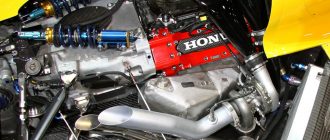- How to Check Car Engine Model
- Introduction
- Method 1: Vehicle Identification Number (VIN)
- Locate the VIN
- Decode the VIN
- Example
- Method 2: Engine Bay Inspection
- Locate the Engine Bay
- Identify the Engine Stamp
- Example
- Method 3: Service Manual
- Locate the Service Manual
- Find the Engine Section
- Example
- Method 4: Parts Catalog
- Obtain a Parts Catalog
- Find the Engine Section
- Example
- Method 5: OBD-II Scanner
- Connect the Scanner
- Run the Scan
- Check the Results
- Example
- Method 6: Owner’s Manual
- Locate the Owner’s Manual
- Find the Vehicle Specifications
- Example
- Conclusion
How to Check Car Engine Model
Introduction
Knowing your car’s engine model is crucial for various reasons, including finding the right parts, performing maintenance, and understanding its capabilities. This comprehensive guide will provide you with detailed instructions on how to check your car engine model using different methods.
Method 1: Vehicle Identification Number (VIN)
The VIN is a unique 17-digit code that identifies your vehicle. It contains valuable information, including the engine model.
Locate the VIN
* Check the driver’s side door jamb.
* Look for a metal plate under the hood, near the firewall.
* Refer to your vehicle’s registration card or insurance policy.
Decode the VIN
* The tenth character of the VIN represents the model year.
* The eighth character represents the engine code.
Example
If your VIN is 1G1ZA5E31D2123456, the eighth character is “E,” which corresponds to a 3.5L V6 engine.
Method 2: Engine Bay Inspection
Locate the Engine Bay
* Open the hood of your car.
* Find the compartment where the engine is located.
Identify the Engine Stamp
* Look for a metal plate or sticker attached to the engine block.
* It usually contains the engine model information.
Example
The engine stamp may read “2.0L EcoBoost,” indicating a 2.0-liter turbocharged engine.
Method 3: Service Manual
Your car’s service manual will provide detailed information about the engine model.
Locate the Service Manual
* Check the glove compartment or owner’s manual holder.
* If not available, download a digital version from the manufacturer’s website.
Find the Engine Section
* Refer to the index or table of contents to locate the engine section.
* The model will typically be listed in the specifications.
Example
The service manual may state that the engine model is “L4-16V VTEC,” denoting a 4-cylinder, 16-valve, Variable Valve Timing engine.
Method 4: Parts Catalog
Auto parts catalogs often include engine model information.
Obtain a Parts Catalog
* Visit the manufacturer’s website or an auto parts store.
* Enter your vehicle’s make, model, and year.
Find the Engine Section
* Navigate to the engine parts section.
* The model will usually be specified in the part descriptions.
Example
The parts catalog may list “3.6L V6 Pentastar” as the engine model for a certain vehicle.
Method 5: OBD-II Scanner
An OBD-II scanner can retrieve various data from your car’s engine control module (ECM).
Connect the Scanner
* Plug the OBD-II scanner into the diagnostic port, usually located under the dashboard.
Run the Scan
* Turn the ignition to the “ON” position without starting the engine.
* Follow the scanner’s instructions to run a diagnostic scan.
Check the Results
* The scan results will display various information, including the engine model.
Example
The OBD-II scanner may show “Engine Model: 1.4L Turbocharged” on the display.
Method 6: Owner’s Manual
Your car’s owner’s manual contains basic information about the vehicle.
Locate the Owner’s Manual
* Check the glove compartment or owner’s manual holder.
Find the Vehicle Specifications
* Refer to the vehicle specifications section.
* The engine model will typically be listed there.
Example
The owner’s manual may state that the engine is a “2.5L Boxer,” indicating a horizontally opposed 2.5-liter engine.
Conclusion
Checking your car’s engine model is a straightforward process using the methods described in this guide. Whether you prefer the convenience of decoding the VIN or the precision of inspecting the engine bay, you can accurately identify the model of your car’s engine and make informed decisions about maintenance and repairs.




